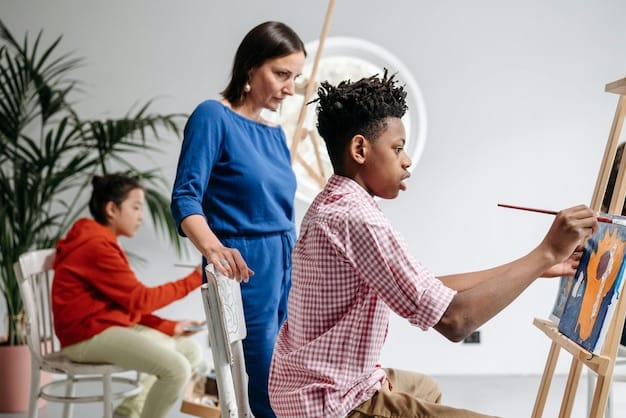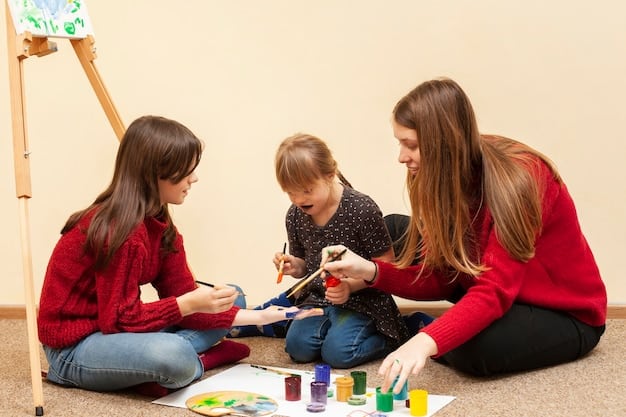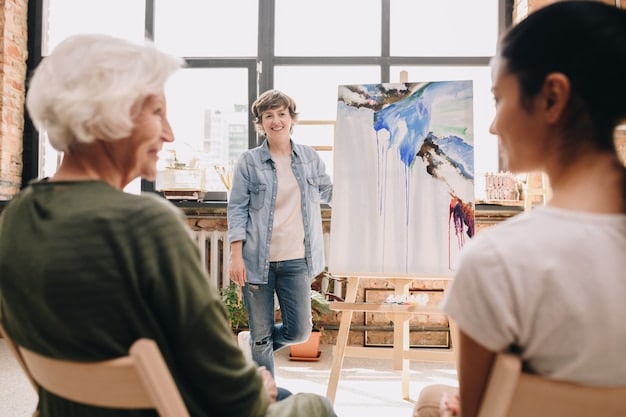The Transformative Impact of Art Therapy on Community Mental Health

Art therapy significantly enhances community mental health by providing a creative outlet for emotional expression, reducing stress and anxiety, promoting self-awareness, and fostering social connections through group activities.
The Impact of Art Therapy: How It’s Transforming Mental Health in Communities is profound. From offering a safe space for emotional expression to fostering a sense of community, art therapy is reshaping how we approach mental wellness. Discover how this innovative approach is making a difference in local communities.
Understanding Art Therapy: A Creative Path to Healing
Art therapy is a specialized field within mental health that uses the creative process to improve mental, emotional, and physical well-being. It’s not about creating masterpieces; it’s about using art as a form of communication and self-expression.
Through various art forms such as painting, drawing, sculpting, and collage, individuals can explore their emotions, reduce stress, increase self-esteem, and gain insight into their thoughts and behaviors. Let’s delve deeper into the core principles that define art therapy and its unique approach to mental health.
Core Principles of Art Therapy
Art therapy operates on several key principles that distinguish it from traditional talk therapy. These principles emphasize the inherent healing power of creativity and self-expression. Understanding these core ideas can illuminate how art therapy effectively supports mental health.
- Creative Expression: Art therapy provides a safe and non-judgmental space for individuals to express emotions that may be difficult to verbalize.
- Mind-Body Connection: Engaging in art activates both the mind and body, promoting a sense of integration and well-being.
- Self-Discovery: The art-making process can lead to new insights and a deeper understanding of oneself.
- Emotional Release: Creating art can be a cathartic experience, allowing for the release of pent-up emotions and stress.
In summary, art therapy is a powerful tool that facilitates emotional expression, enhances self-awareness, and promotes overall well-being. Its holistic approach addresses both the mind and body, making it a valuable asset in community mental health programs.
Benefits of Art Therapy for Mental Health
The benefits of art therapy extend to various aspects of mental health, making it a versatile and effective therapeutic approach. It can help individuals cope with stress, anxiety, depression, trauma, and other mental health challenges.
Art therapy offers a unique way to process emotions and experiences that may be difficult to address through traditional methods. The following sections explore these benefits in detail, highlighting how art therapy interventions can significantly improve mental well-being.

Reducing Stress and Anxiety
Art therapy has been shown to reduce stress and anxiety levels by providing a calming and engaging activity. The act of creating art can be meditative, allowing individuals to focus on the present moment and quiet their minds.
Studies have indicated that even brief periods of art-making can lower cortisol levels, the hormone associated with stress. This makes art therapy a valuable tool for managing daily stressors and promoting relaxation.
Improving Emotional Regulation
Art therapy interventions can help individuals develop better emotional regulation skills. By exploring emotions through art, people can learn to identify, understand, and manage their feelings more effectively.
This is particularly beneficial for those who struggle with expressing their emotions verbally. Art becomes a bridge, allowing them to communicate their inner experiences in a safe and constructive way.
- Enhances Self-Awareness: Art therapy prompts reflection, helping individuals become more attuned to their thoughts and feelings.
- Promotes Emotional Expression: It provides a non-verbal outlet for expressing emotions, which can be especially helpful for those who find it difficult to articulate their feelings.
- Builds Coping Skills: Art therapy equips individuals with creative coping strategies for managing stress and challenging emotions.
In conclusion, art therapy offers numerous benefits for mental health, including stress reduction, improved emotional regulation, and enhanced self-awareness. Its holistic approach makes it a valuable complement to traditional mental health treatments.
Art Therapy Techniques and Modalities
Art therapy encompasses a variety of techniques and modalities, each tailored to meet the specific needs and goals of the individual or group. These methods range from traditional art forms to innovative approaches that leverage the therapeutic power of creativity.
Exploring different art therapy techniques can help identify the most effective ways to engage with the healing process. Let’s consider some of the most common and impactful modalities used in art therapy practice.
Painting and Drawing
Painting and drawing are fundamental techniques in art therapy, offering a wide range of possibilities for self-expression. These methods allow individuals to explore color, form, and texture, conveying emotions and ideas through visual representation.
The simplicity and accessibility of painting and drawing make them suitable for people of all ages and skill levels. Whether using watercolors, acrylics, pencils, or charcoal, these techniques provide a versatile means of creative exploration.
Sculpting and Clay Work
Sculpting and clay work involve creating three-dimensional forms, which can be particularly powerful for expressing emotions and experiences related to the body. The tactile nature of clay allows for a direct and visceral engagement with the creative process.
Working with clay can be grounding and therapeutic, helping individuals to connect with their physical selves and release tension. It’s also a great medium for exploring themes of transformation and change.
- Collage: This technique involves assembling various materials, such as paper, fabric, and found objects, to create a composite image.
- Mandala Art: Creating mandalas, circular designs with intricate patterns, can promote relaxation, mindfulness, and self-reflection.
- Digital Art: Using digital tools and software to create art can be a modern and engaging way to explore creative expression and therapeutic goals.
Thus, the diverse range of art therapy techniques provides multiple avenues for individuals to explore their inner world, express their emotions, and promote healing. These modalities can be adapted to suit various needs and preferences, making art therapy a highly personalized and effective therapeutic approach.
Art Therapy in Community Settings
Art therapy is increasingly being integrated into various community settings, providing accessible mental health support to diverse populations. Its adaptability makes it a valuable resource in schools, hospitals, community centers, and correctional facilities.
By bringing art therapy into the community, mental health services become more accessible, inclusive, and responsive to local needs. Let’s examine how art therapy is making a difference in these settings and the positive impact it has on individuals and the community as a whole.

Schools and Educational Institutions
In schools, art therapy can support students struggling with academic stress, social challenges, or emotional difficulties. It provides a creative outlet for self-expression and helps students develop coping skills and emotional resilience.
Art therapy programs in schools can also foster a more inclusive and supportive learning environment, promoting positive mental health and well-being among students and staff.
Hospitals and Healthcare Facilities
Art therapy is used in hospitals to support patients coping with illness, injury, or medical procedures. It can help reduce pain, anxiety, and depression, and improve overall quality of life.
Art therapy interventions in healthcare settings often focus on promoting relaxation, emotional expression, and a sense of control during challenging times. It provides patients with a creative and empowering way to navigate their health journey.
- Community Centers: Art therapy programs in community centers offer accessible mental health support to individuals of all ages and backgrounds.
- Correctional Facilities: In correctional facilities, art therapy can help inmates address trauma, manage anger, and develop pro-social behaviors.
- Senior Centers: Art therapy programs in senior centers can promote cognitive function, emotional well-being, and social engagement among older adults.
Consequently, art therapy’s integration into community settings enhances mental health accessibility and provides tailored support to diverse populations. Its presence in schools, hospitals, community centers, and correctional facilities underscores its versatility and the broad benefits it offers to community well-being.
Overcoming Barriers to Accessing Art Therapy
Despite the growing recognition of art therapy’s benefits, several barriers can impede access to these services. These barriers include financial constraints, lack of awareness, cultural stigma, and geographical limitations.
Addressing these challenges is crucial to ensuring that everyone who could benefit from art therapy has the opportunity to do so. This section explores strategies to overcome these barriers and promote equitable access to art therapy services in communities.
Financial Constraints
The cost of art therapy can be a significant barrier for many individuals and families. Limited insurance coverage and lack of funding for community programs can make it difficult to afford these services.
To address this, advocating for increased insurance coverage, seeking grant funding for community-based art therapy programs, and offering sliding scale fees can help make art therapy more affordable and accessible.
Lack of Awareness
Many people are unaware of the availability and benefits of art therapy. This lack of awareness can prevent individuals from seeking out these services when they could be helpful.
- Cultural Stigma: Cultural stigma surrounding mental health can prevent individuals from seeking help, including art therapy. Addressing this requires culturally sensitive outreach and education efforts.
- Geographical Limitations: In rural or underserved areas, access to art therapy services may be limited due to a shortage of qualified therapists. Telehealth and mobile art therapy programs can help bridge this gap.
In summary, overcoming barriers to accessing art therapy requires a multi-faceted approach that addresses financial constraints, lack of awareness, cultural stigma, and geographical limitations. By implementing these strategies, communities can work towards ensuring that everyone has the opportunity to benefit from the healing power of art.
The Future of Art Therapy in Community Mental Health
The future of art therapy in community mental health is promising, with increasing recognition of its effectiveness and potential. Innovations in technology, research, and practice are expanding the reach and impact of art therapy.
As communities continue to prioritize mental health and well-being, art therapy is poised to play an increasingly important role in promoting healing, resilience, and social connection.
Integrating Technology
Technology is opening new doors for art therapy, with the development of digital art tools, telehealth platforms, and virtual reality experiences. These innovations can make art therapy more accessible, engaging, and personalized.
Telehealth art therapy sessions can reach individuals in remote areas, while digital art tools provide new avenues for creative expression and therapeutic exploration.
Expanding Research
Continued research is essential to further validate the effectiveness of art therapy and identify best practices for various populations and conditions. Studies exploring the neurological and physiological effects of art-making can provide valuable insights into its healing mechanisms.
- Promoting Advocacy: Advocacy efforts are crucial to raising awareness of art therapy and securing funding for community programs.
- Fostering Collaboration: Collaboration between art therapists, mental health professionals, educators, and community leaders can enhance the integration of art therapy into various settings.
In conclusion, the future of art therapy in community mental health is bright, with technology, research, and advocacy driving its growth and integration. By embracing these opportunities, communities can harness the full potential of art therapy to promote mental wellness and social connection for all.
| Key Point | Brief Description |
|---|---|
| 🎨 Creative Expression | Offers a non-verbal outlet for emotions. |
| 🧘 Stress Reduction | Lowers cortisol levels and promotes relaxation. |
| 🤝 Community Building | Fosters connections and support through group sessions. |
| 🧠 Emotional Regulation | Helps manage and understand feelings effectively. |
Frequently Asked Questions (FAQ)
▼
Art therapy is a mental health profession that uses creative methods to improve well-being. It involves a trained therapist guiding individuals through art-making to explore emotions and thoughts, fostering self-awareness and healing.
▼
Art therapy is beneficial for people of all ages and backgrounds. It helps those dealing with stress, anxiety, depression, trauma, and various mental health challenges. No artistic skill is required to participate and benefit from it.
▼
Art therapy utilizes a wide range of art forms, including painting, drawing, sculpting, collage, and digital art. The choice of art form depends on individual preferences and therapeutic goals, offering diverse avenues for expression.
▼
To find a qualified art therapist, look for professionals certified by the Art Therapy Credentials Board (ATCB). Professional organizations and online directories are helpful in locating licensed and experienced therapists in your area.
▼
Coverage for art therapy varies by insurance plan. Contact your insurance provider to inquire about mental health benefits and coverage for art therapy services. Some community programs also offer low-cost or free art therapy sessions.
Conclusion
In conclusion, the impact of art therapy: how it’s transforming mental health in communities is undeniable. As a creative and accessible approach to mental wellness, art therapy offers unique benefits for individuals and communities alike. By promoting emotional expression, reducing stress, and fostering social connection, art therapy is making a significant difference in the lives of those it touches, paving the way for a more compassionate and mentally healthy future.





